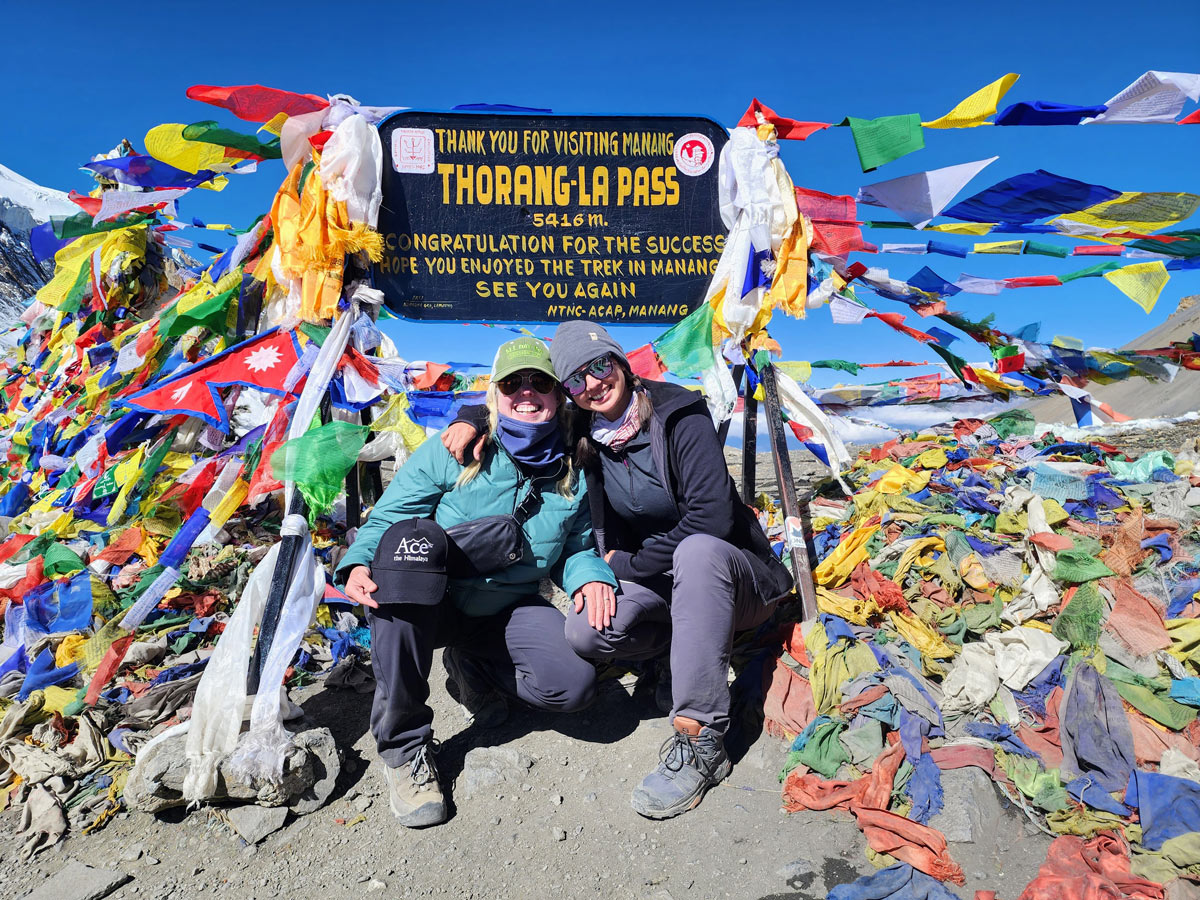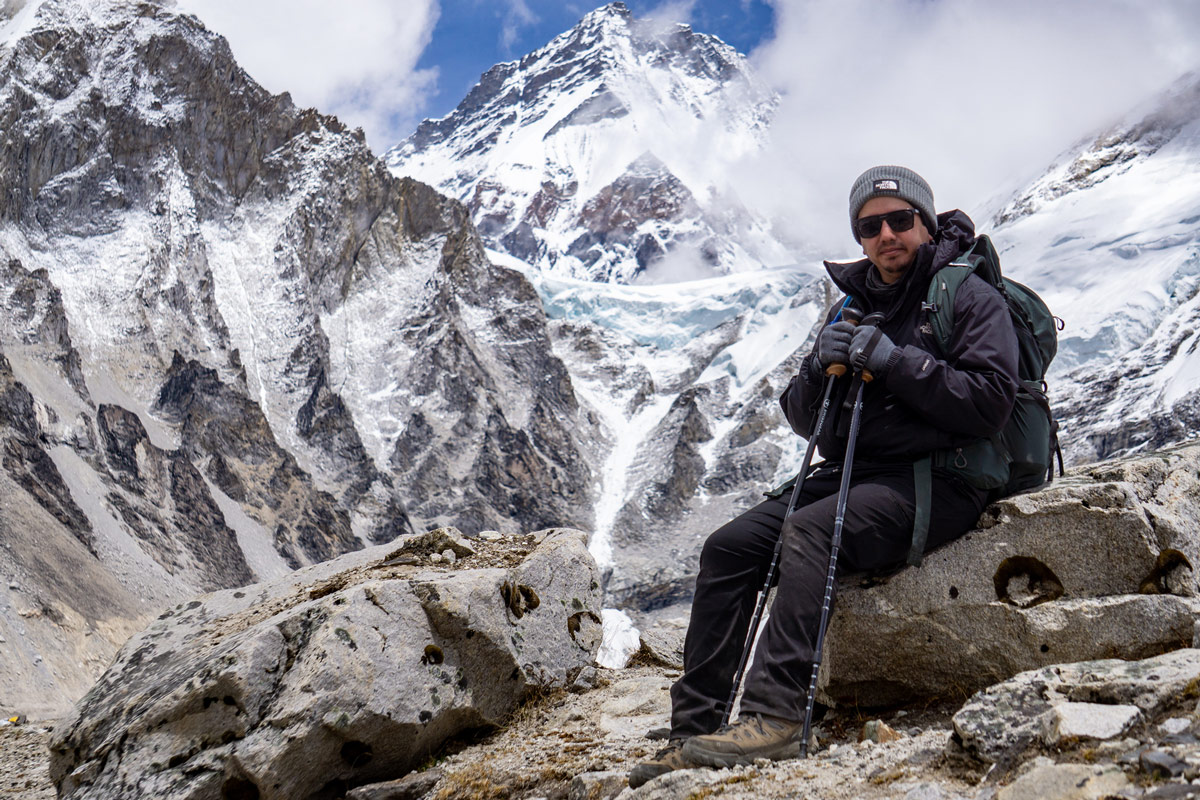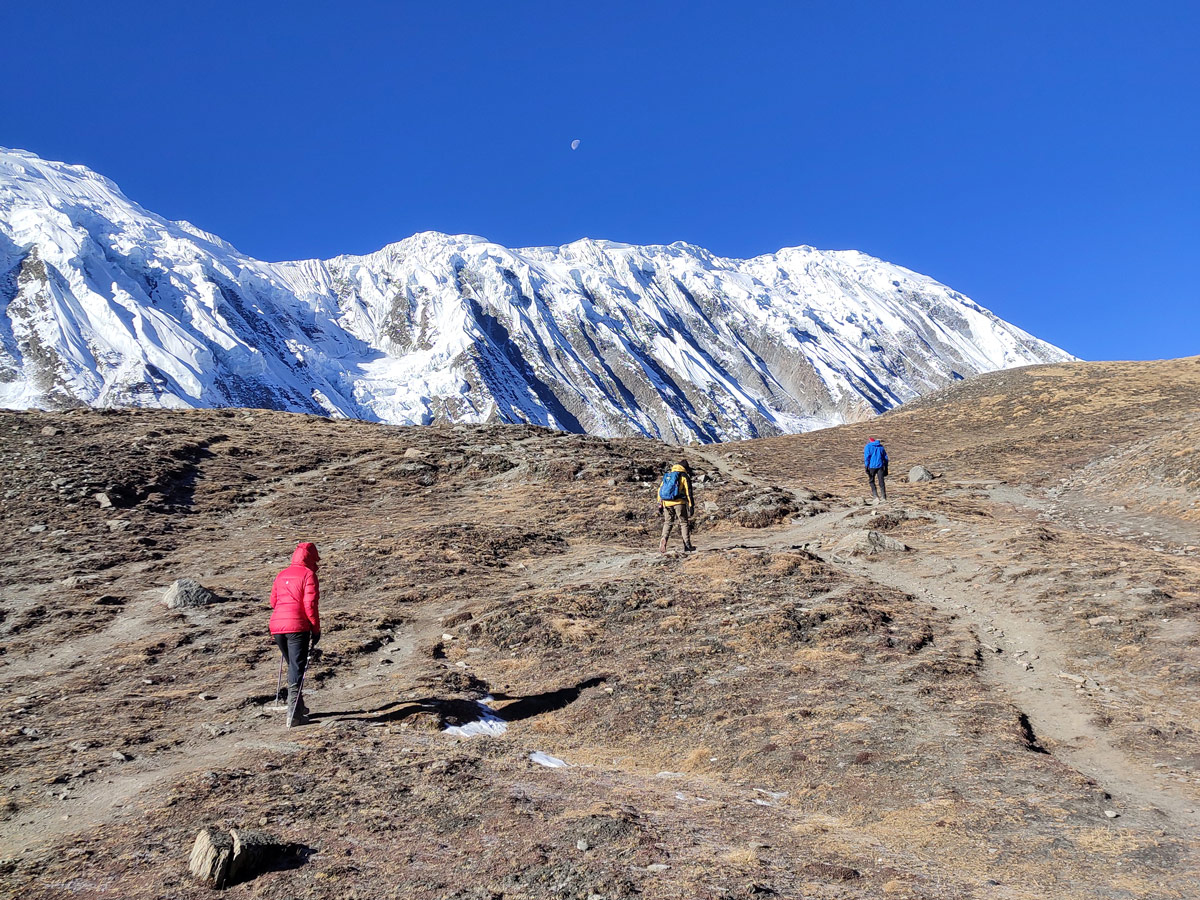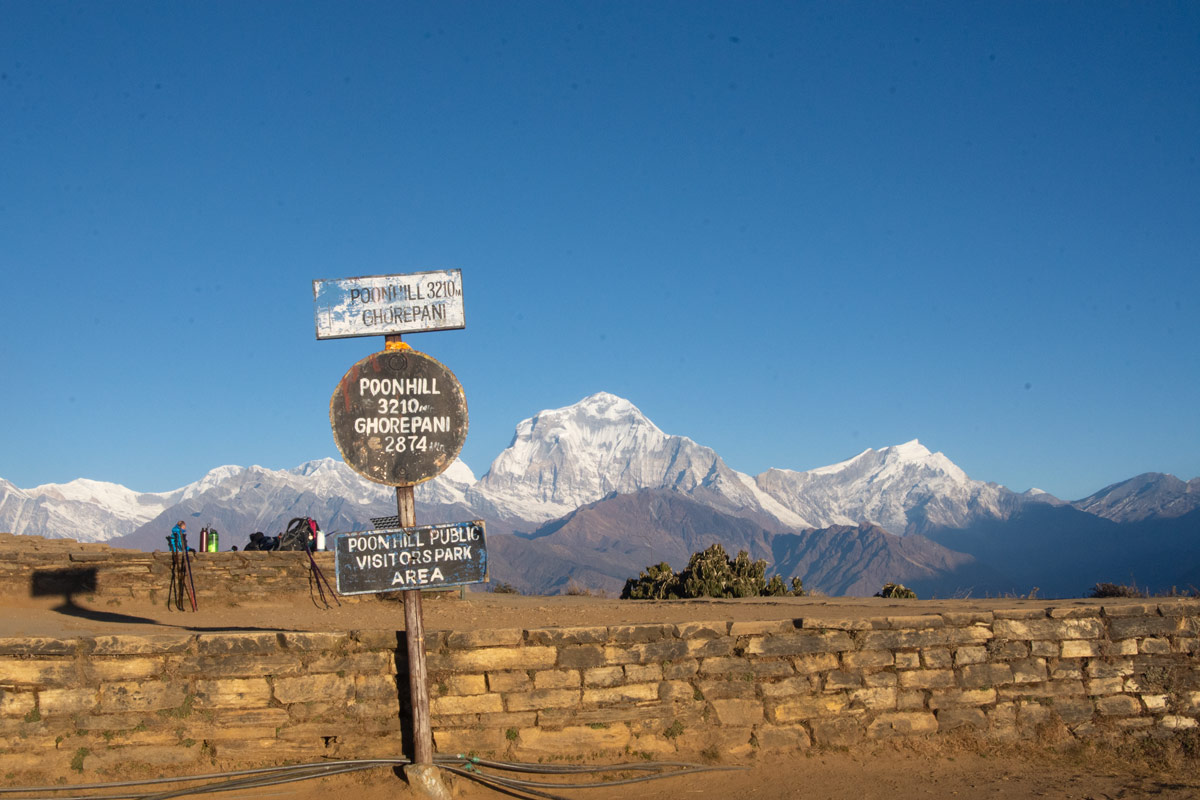Embarking on the iconic Annapurna Circuit trek means setting out for a journey of a lifetime amidst the stunning landscapes and surrounded by the breathtaking Himalayan majesty of Nepal.
While every season on this trek is a spectacular odyssey, what if you had the chance to take your adventure up a notch by picking the best time for Annapurna Circuit trek based on your preferences and requirements? Sounds too good to be true, doesn’t it?
Well, it doesn’t have to be. Picking the perfect season not only enhances your experience but also allows you to complete the trek with much more convenience rather than dragging your feet till the end of the trek.
Therefore, in this blog, we have broken down what each season on these majestic trails has to offer you and which one can be the perfect season for your dream adventure.
Seasonal Overview of the Annapurna Circuit
Nepal features a rather unique seasonal cycle because of the geographical formation of the country. The months in Nepal are classified into four main seasons: Spring (March to May), Monsoon (June to August), Autumn (September to November), and Winter (December to February).
The diverse landscapes of Nepal differ from season to season giving a unique yet equally beautiful experience with its own set of challenges and rewards making it tough to pick the best time to visit Nepal.
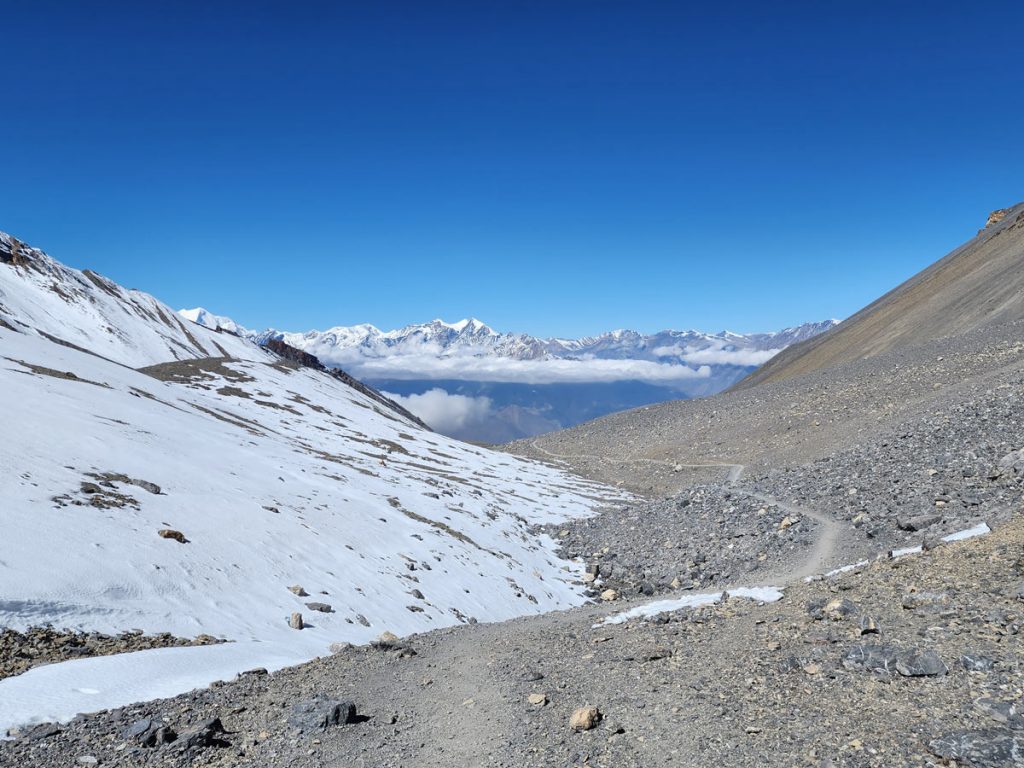
When it comes to the Annapurna Circuit trek, the trek is open all year round with visitors being allowed to trek the region in every season given that they have the required permits and documents.
However, some seasons on this trek are more rewarding than others as the challenges on the trail overpower the rewards during some months. Therefore, below is a breakdown of what to expect during each season while trekking the Annapurna Circuit.
Trekking to Annapurna Circuit in Spring (March to May)
Also known as pre-monsoon, the months of March to May mark the spring season in Nepal which is also known as the peak trekking season in the country.
Trekking the Annapurna circuit during the spring season is like witnessing a live painting with a symphony of colors.
This season strikes the perfect balance between comfortable temperatures and a riot of colors as the lush valleys in the Annapurna conservation Area are adorned with vibrant hues of pink, red, and white rhododendrons and wildflowers carpet the hillside.
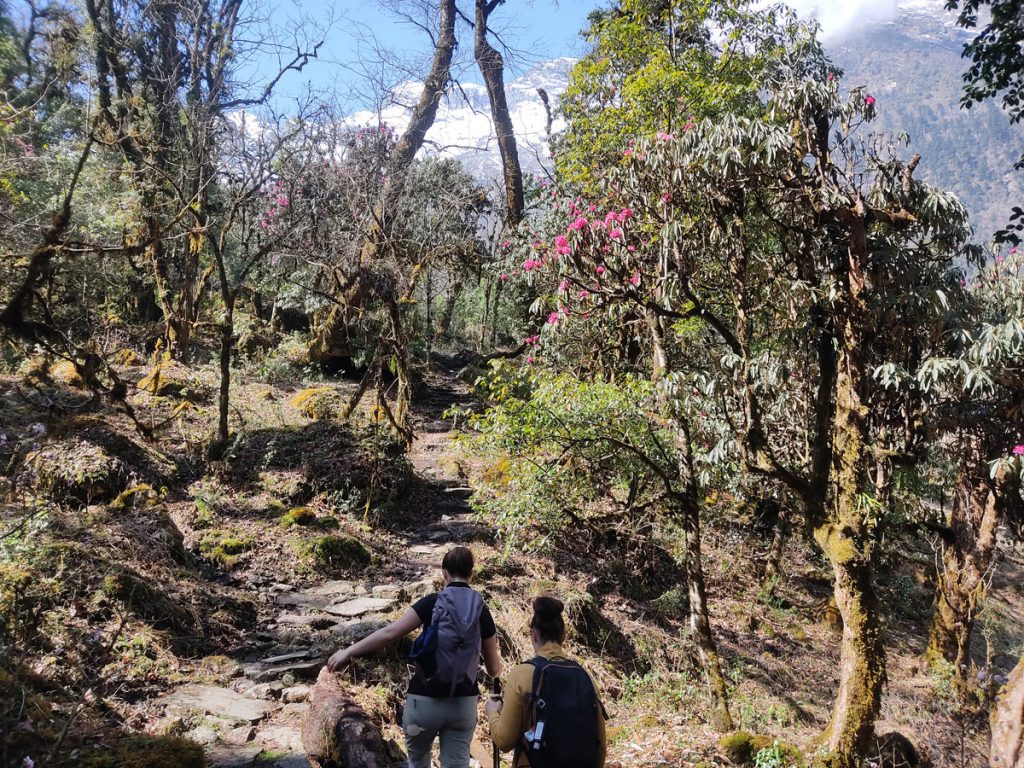
The snow from winter begins to melt and temperatures on the trail become mild allowing the trekkers to have a smooth ascent, neither drowning in sweat nor freezing due to the snow. The temperatures range from 5 degrees to 20 degrees Celsius.
The chances of snow or rainfall are minimal as the circuit boasts clear skies, therefore giving a perfect and unobstructed view of the towering Himalayan giants like Annapurna and Dhaulagiri ranges, which is one of the main reasons why you would trek the Annapurna circuit.
Having said that, there might still be snowfall so make sure to arrange your packing list for Annapurna Circuit trek accordingly and include the likes of spikes, jackets, and more.
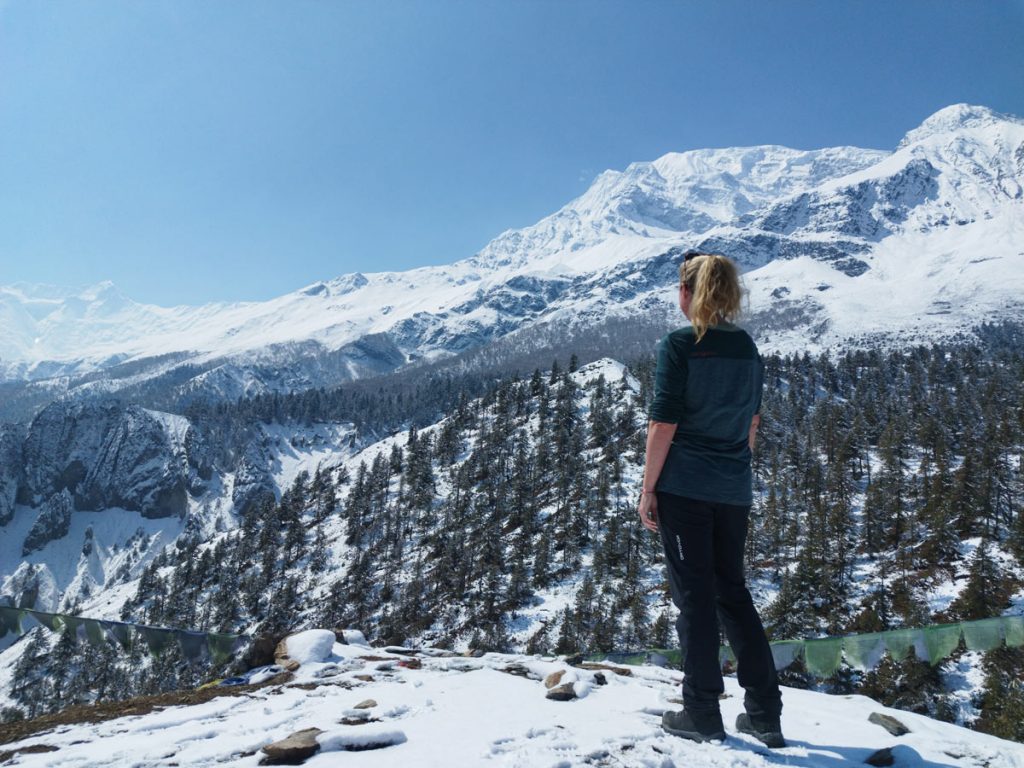
For wildlife enthusiasts alike, trekking the Annapurna circuit during spring is a treat as the wildlife is highly active after their winter slumber, forming many chances for spotting animals as well as birds.
The months of spring also bring along some local festivals like Holi, Nepali New Year, and more which means lots of local traditions and celebrations await you. However, these perks bring their challenges during the trek.
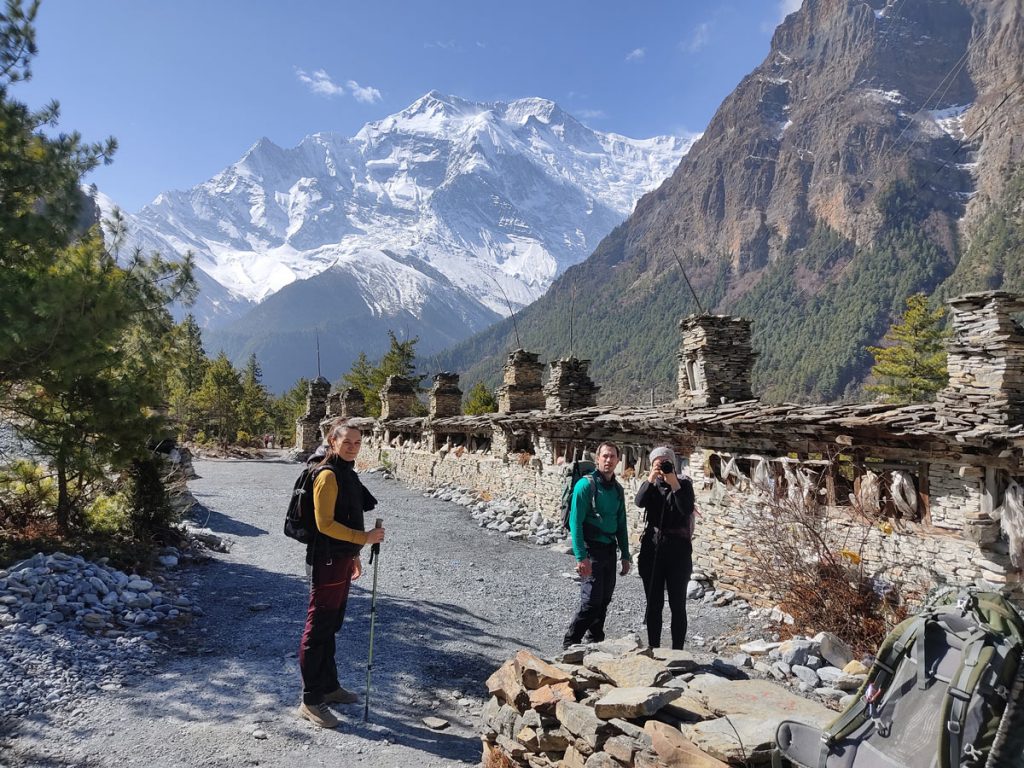
Given the perfect trekking conditions of Spring, the circuit experiences a huge surge as people from all over the world make their way to this iconic trek.
The trekker’s traffic on this trek during the Spring season is something that might not be a part of everybody’s dream adventure.
Monsoon (June to August)
In the months of June to August, Nepal welcomes the monsoon season which brings lots of rain and transforms the Annapurna Circuit trail into a lush and verdant paradise. However, it also comes with challenges like heavy rainfall, limited visibility, and chances of landslides.
This season is also known as the shoulder season as not many people trek the Annapurna Circuit during the monsoons. This is because of the increased risks like slippery trails and potential landslides due to the unexpected and heavy rainfall.
There is less visibility on the trail even during afternoons due to the fog and rain. Along with that, the Annapurna Circuit trail is infested with leeches during monsoon. Therefore, packing suitable gear like proper hiking boots and gaiters is very important.
Having said that, trekking the Annapurna Circuit during monsoon also comes with its perks. For those wanting to get a solitary trekking experience, this is the best time as you won’t find many people on the trail.
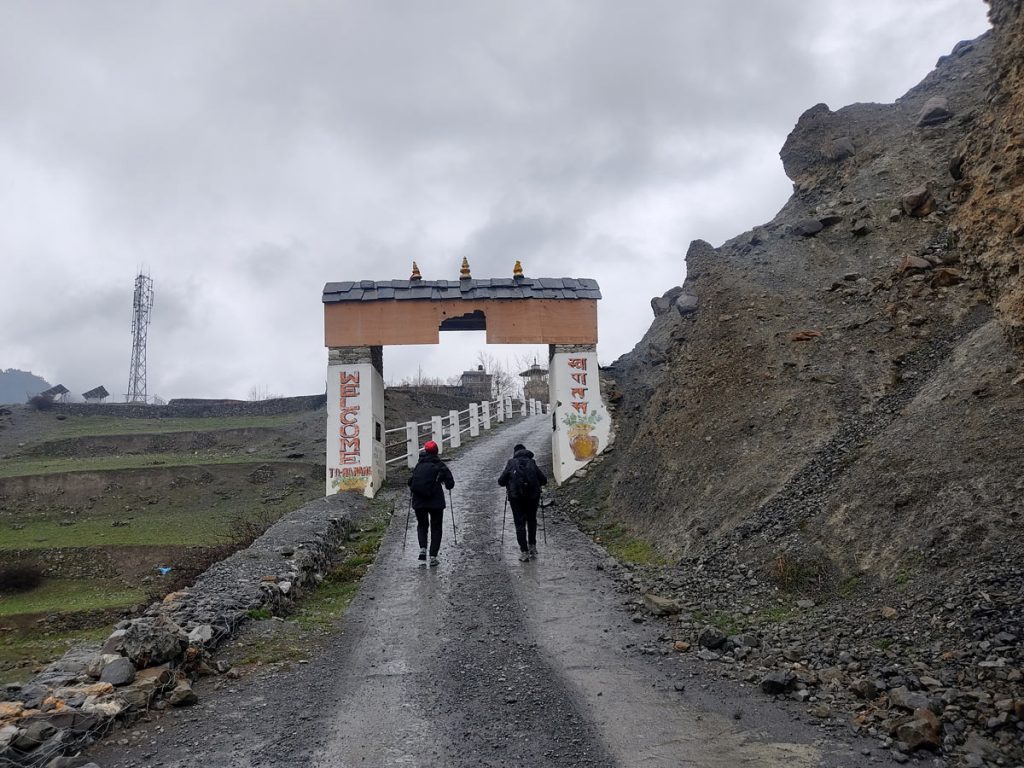
Besides that, the majestic waterfalls, rivers like Marshyangdi and Kali Gandaki, as well as the flora and landscapes are blooming and vibrant due to the rainfall. The experience is extremely rich in terms of biodiversity.
Temperatures are not much of a problem during monsoon as they are neither scorching hot nor freezing cold.
The temperature range on the circuit during these months ranges from –3 degrees celsius at higher altitudes and up to 25 degrees celsius at lower altitudes.
Due to the availability of alternative routes as well as the dirt road on the Annapurna Circuit trek, it is also possible to avoid trail blockage due to potential landslides.
However, trekking the Annapurna circuit during this season demands prior experience and thorough preparation. A suitable option for trekkers wanting to trek the region during monsoon could be the northern sections of the trek that are located in the rain shadow of Annapurna massif.
While planning your itinerary, make sure to research the weather patterns and make a foolproof packing list including rain gear like waterproof bags, waterproof boots, rain jackets, and rain pants too.
Annapurna Circuit Trek in Autumn Season (September to November)
The months of September to November mark the Autumn season in Nepal. Same as Spring, autumn is also the peak trekking season in Nepal, and it is also considered the best time to visit Nepal given the comfortable conditions and the festive atmosphere.
During this season of unparalleled beauty, the Annapurna Circuit experiences a tandem of crystal clear skies and spectacular panoramas. The weather is perfect too with a hint of crispiness and chill indicating the approaching winter.
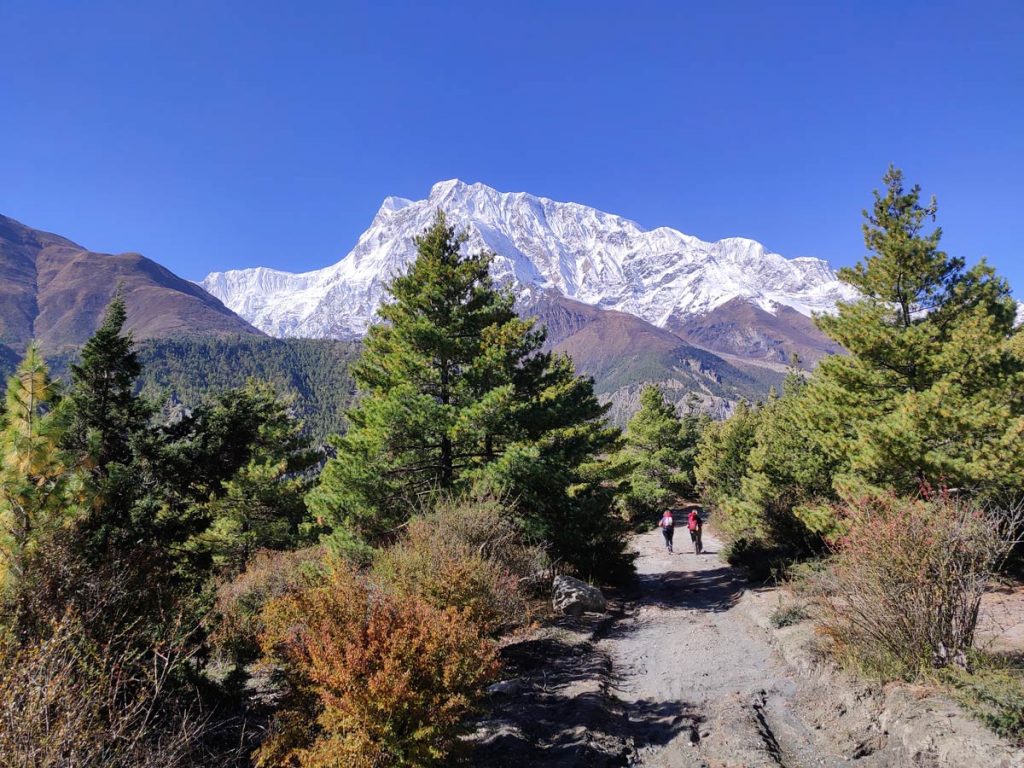
The temperature on the Annapurna Circuit during the months of autumn ranges from 4 degrees celsius to 20 degrees celsius giving it the perfect setting for trekking. The nighttime temperatures, however, can go up to –5 degrees celsius, so prepare your packing list accordingly.
Besides that, the season features clear skies as the monsoon rains have settled. The air is fresh and without haze allowing the trekkers to catch perfect glimpses of the mountain ranges. While there might be a chance of snowfall during the end of autumn, precipitation is very low.
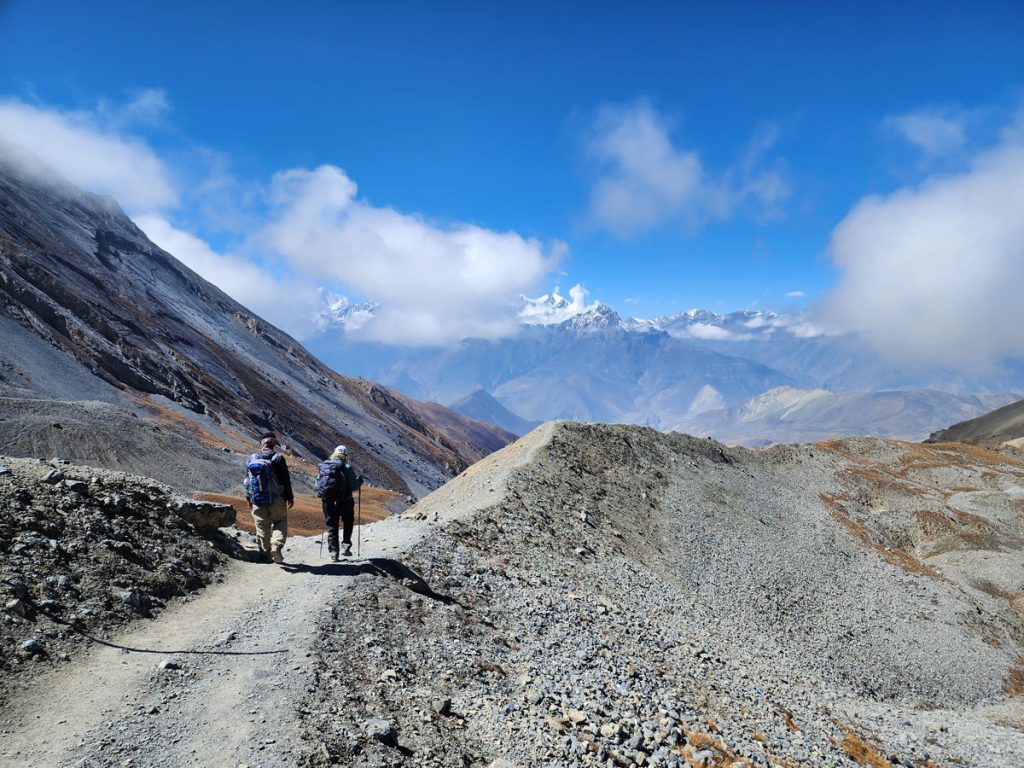
Crossing Thorong La pass to reach MuktinathThe cultural experience on the trail during autumn is also truly unmatched as this is the season when most of the significant local festivals like Dashain and Tihar take place. Therefore, you get a chance to participate in the local traditions.
However, be prepared to share the trail with other fellow trekkers as this season, similar to spring, experiences a huge influx of tourists wanting to trek the Annapurna Circuit. It is advisable to make your bookings for accommodation, guides, and porters well in advance.
Annapurna Circuit in Winter (December to February)
The winter season spanning from December to February on the Annapurna Circuit trek is a uniquely challenging experience but with epic rewards. During this season, the Annapurna circuit transforms into a winter wonderland, almost resembling a heavenly experience.
Trekking the region during winter means walking through the pristine landscapes of mountains blanketed in snow and untouched by the crowds as this too is a shoulder season. Therefore, you will have the trail all to yourself and breathe in the sanctity of the Himalayas.
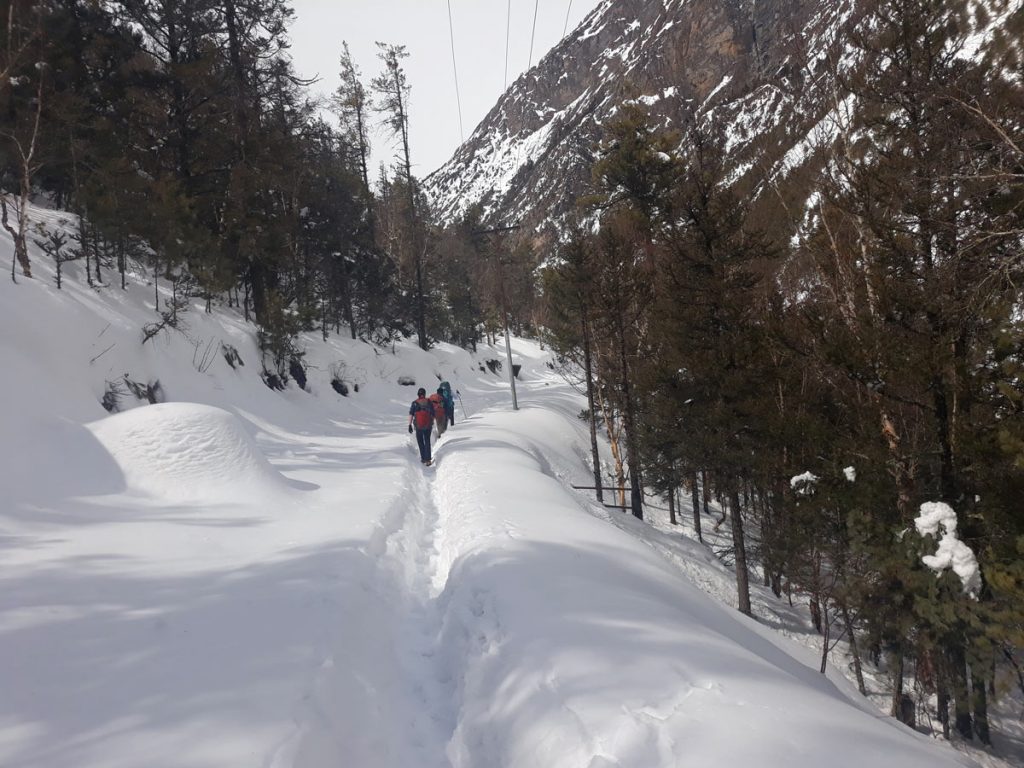
You will be accompanied by nothing but the mountains. Thanks to this, you will also find that most of the teahouses in the region are empty allowing you to get a small perk of using as many blankets as you need to keep yourself warm.
The landscapes become stark and serene with not much activity of wildlife. The skies are absolutely clear with no chance of rainfall. Thus, trekkers get a perfect view of each and every peak in the region as they are shining bright and visible from even far away.
Snowfall is a frequent occurrence and adds to the beauty of the landscape. However, with the beauty comes the challenges as the same snow also makes the trail highly slippery making it slightly risky and very difficult to trek in the region.
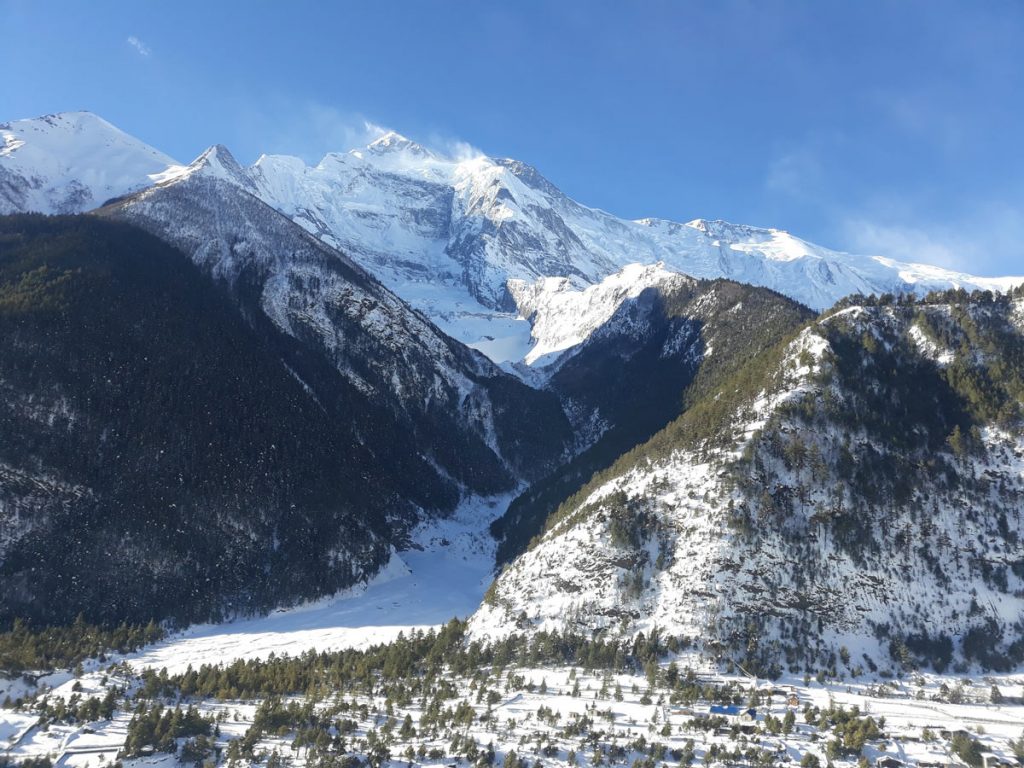
Snowfall might also lead to trail blockage and sometimes even block some of the major attractions and reasons to trek the Annapurna Circuit including the mountain passes like the Thorong La Pass and you might not get a chance to cross it.
The temperatures are freezing cold ranging from 5 to 10 degrees Celsius during the daytime and –10 to –15 degrees celsius at nighttime with increased chances of frost nips and frost bites as well as other health ailments.
For the gutsy explorers wanting to trek the Annapurna circuit during winter, proper preparation and prior experience are necessary. Carry spikes and ice blades to tackle the snow-covered trails along with crampons and ice axes.
Carrying clothing suitable for extreme winters like fleece jackets, zero-degree sleeping bags, and lots of insulated inner layers is very important too.
Choosing the Best season for Annapurna Circuit Trek
There is no such thing as the ‘wrong time for Annapurna Circuit trek’. While different seasons offer a different experience altogether, there is no definite answer about the best time for trekking the Annapurna Circuit as the answer is subjective and based on the personal preferences of the trekker.
However, we have put in place some factors that can help you assess the best time for your Annapurna Circuit Trek adventure.
Personal Preferences
You can pick a suitable season based on what you want out of your trekking adventure. If you are someone more inclined towards witnessing the scenery and the floral bliss of the Annapurna Circuit along with spotting the wildlife activities in the region, Spring is the best pick for you.
Along with witnessing the trails bursting with floral fantasia, you can also trek in comfortable weather conditions and get the perfect view of the mountains. So it is a win-win and therefore considered the peak trekking season.
If you are looking forward to a rich cultural experience, the months of autumn coinciding with the major Nepali festivals are the best pick. With the unique tandem of perfect visibility and crisp air, you can get a refreshing experience while enjoying all the highlights of the Annapurna Circuit.
However, if trekking in solitude and escaping the hustle and bustle of daily life is a priority, consider trekking the Annapurna Circuit during winter when this winter wonderland is shining with the snow and you can have it all to yourself.
Although we advise against trekking the Annapurna circuit during monsoon, if you have prior experience and a true interest in experiencing the monsoon challenges of the trek, the months from June to August are also a good option to escape the crowds and enjoy the majesty of nature in its full might.
Physical Preparation and Prior Experience
Although it is true that the Annapurna Circuit trek can be a good trekking option for beginners, some seasons on the trek are more demanding than others and can demand prior experience to tackle the challenges.
Trekking the region during winter demands a high level of physical fitness and mountaineering skills to navigate the snow and ice on the trek. Monsoons also demand technical strength as you will have to navigate the slippery trails amidst the low visibility.
If you are a beginner with an average level of physical fitness, spring and autumn might be the best season for Annapurna Circuit trek for you.
Things to know before planning your trek
Once you have figured out the best season for your Annapurna Circuit trek, there are other things that you must keep in consideration for a successful and comfortable experience during the trek.
- You require permits like the TIMS (Trekkers Information Management System) Card and ACAP (Annapurna Conservation Area Permit) to trek the Annapurna Circuit as it is located in one of the conservation areas of Nepal. Make sure you have it in place.
- Create an elaborate packing list for the Annapurna Circuit trek and include all the essentials like season appropriate clothing, first aid, sleeping gear, and more.
- Do not carry excessive luggage as there are weight limits when a porter is carrying your luggage based on ethical porter practices.
- Research about the local customs and traditions and learn a word or two like ‘Namaste’ to make your experience much better.
- Hire a guide as solo trekking is banned in Nepal. Hiring a guide also means putting yourself in safe hands and having a much better exploration as the local guides know the area in and out.
- It is best to partner with a local trekking agency like Ace the Himalaya as it saves you the hassle of figuring out the accommodation, guides, permits, as well as porters.
- Start preparing early to achieve the physical fitness required for the trek.
What is the best season to avoid crowds while trekking the Annapurna Circuit?
While autumn and spring offer favorable trekking conditions, the best season to avoid crowds while on the Annapurna Circuit is definitely the winter season spanning from December to February.
Due to colder temperatures and high amount of snowfall, the Annapurna Circuit experiences relatively less trekkers traffic during this season. The wildlife activity is low with potential blockage at mountain passes.
However, you also get a perfect Himalayan experience with snow blanketed trails and clear skies along with the postcard perfect view of the silvery mountains standing not very far away.
If you are planning to go on this solitary experience, make sure to be prepared for the freezing temperatures and shorter days on the trek.
Can I trek the Annapurna Circuit during monsoon season?
The Annapurna Circuit trek is open all year round, which means theoretically you can trek the circuit during monsoon (June to August) too. However, it might not be a very good idea practically.
During these months, the circuit experiences a high amount of rainfall which brings lots of challenges like slippery trails, risk of landslides, and your experience might also get uncomfortable due to frequent rains.
The trails are infested with leeches which might not be the experience that you are looking for. Also, the risk of injuries and accidents is very high.
While one advantage is a solitary experience without much crowd, the challenges overpower the advantage. However, for those truly wanting to experience the region during monsoon, you can opt for the northern parts of the circuit.
These parts include some of the rain shadow areas like Mustang which experience relatively less rainfall and can be your go to adventure in the Annapurna Conservation Area during monsoon.
